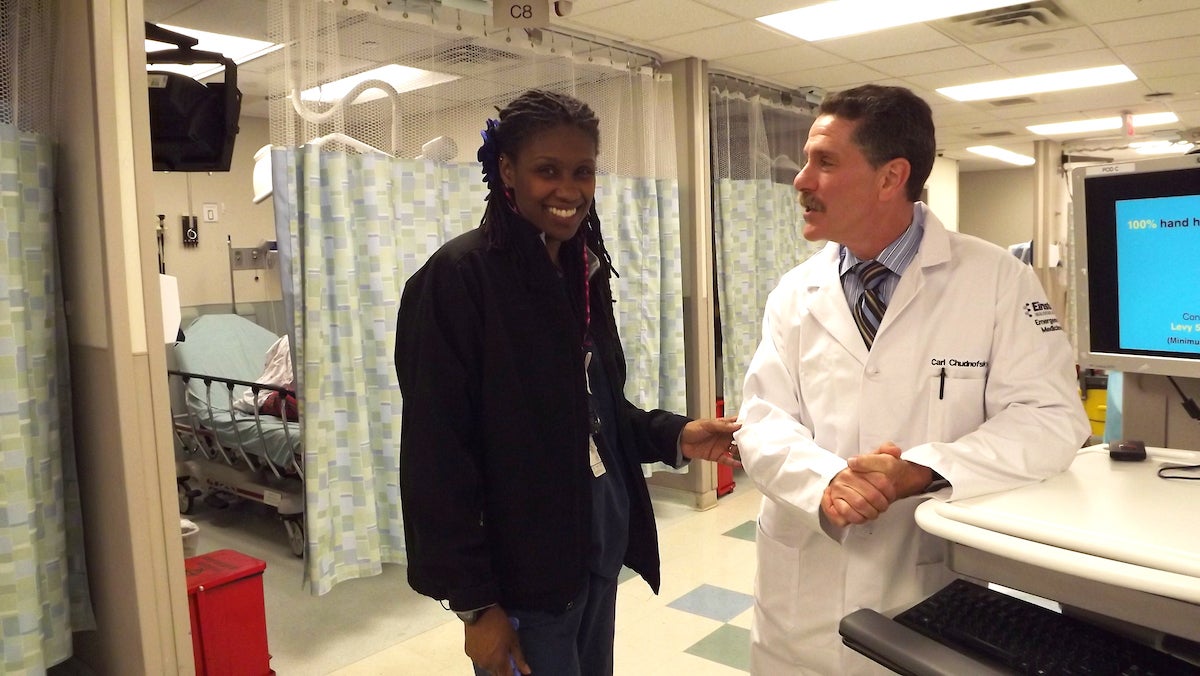The art of triage — one emergency room’s approach
Listen
Nurse Keenya Eubanks with Dr. Carl Chudnofsky
A look at the systems one medical emergency department uses to keep from getting bogged down.
Einstein Medical Center’s North Philadelphia campus emergency medicine department is a serious operation. The unit has about 69 beds in five pods. It has its own nurses, clinicians and support staff, and a dedicated imaging department, lab and pharmacy.
Still, Dr. Carl Chudnofsky, chairman of the Department of Emergency Medicine for Einstein Healthcare Network, wouldn’t mind being even bigger, “We have a large ED, but it’s kind of like money, you know? It’s never enough.”
The beds fill up quickly, and not just with traumatic injuries.
“As an urban emergency department we tend to see a lot of patients at both ends of the acuity spectrum,” says Chudnofsky.
The department sees a lot of patients who are sick because they have not had access to care or medicine and patients who are using the emergency department as their 24-hour, 7-day-a-week primary care provider.
“While we see lots of sick people and we have some life saving circumstances, a lot of what we do is, typically, primary care, seeing patients with back pain or leg pain or belly pain,” he said.
To keep the emergency department from bogging down, Einstein uses a number of systems to provide care to people whose conditions aren’t life-threatening. Fast Track is for walk-in, urgent-care patients. Mini Clinic handles even less acute cases ― patients who do not need to lie down to be treated. The goal of both systems is to get patients in and out in 90 minutes or less. Fast Track is open from 10 a.m. to 10 p.m. and Mini Clinic from 11 a.m. to 11 p.m. every day.
Even with systems to expedite treatment, the emergency department can fill up. When that happens, it falls to the staff to deal with any impatient patients.
Nurse Keenya Eubanks is a pro with navigating patients’ stress. As she gives a tour of the emergency medicine department she greets technicians and ambulance drivers, jokes with fellow nurses, waves at doctors and maintenance staff. At the security desk she switches to Spanish to chat with a guard. While she is a highly skilled registered nurse, Eubanks says that in her line of work, good people skills are crucial.
“We’re getting patients when they are vulnerable, they’re angry and they’re stressed,” she said.
Sometimes the best medicine is simply listening. “You have to genuinely listen. You let them vent, and they can get it off their chests,” Eubanks said.
She said that she strives to earn every patient’s trust and give patients the kind of attention that she would give a family member. On the day The Pulse visited, she was in blue scrubs, tending to patients with a matching blue flower tucked into her hair. “In order to work in the emergency department, you have to truly like people, or there’s no place for you here.”
WHYY is your source for fact-based, in-depth journalism and information. As a nonprofit organization, we rely on financial support from readers like you. Please give today.



